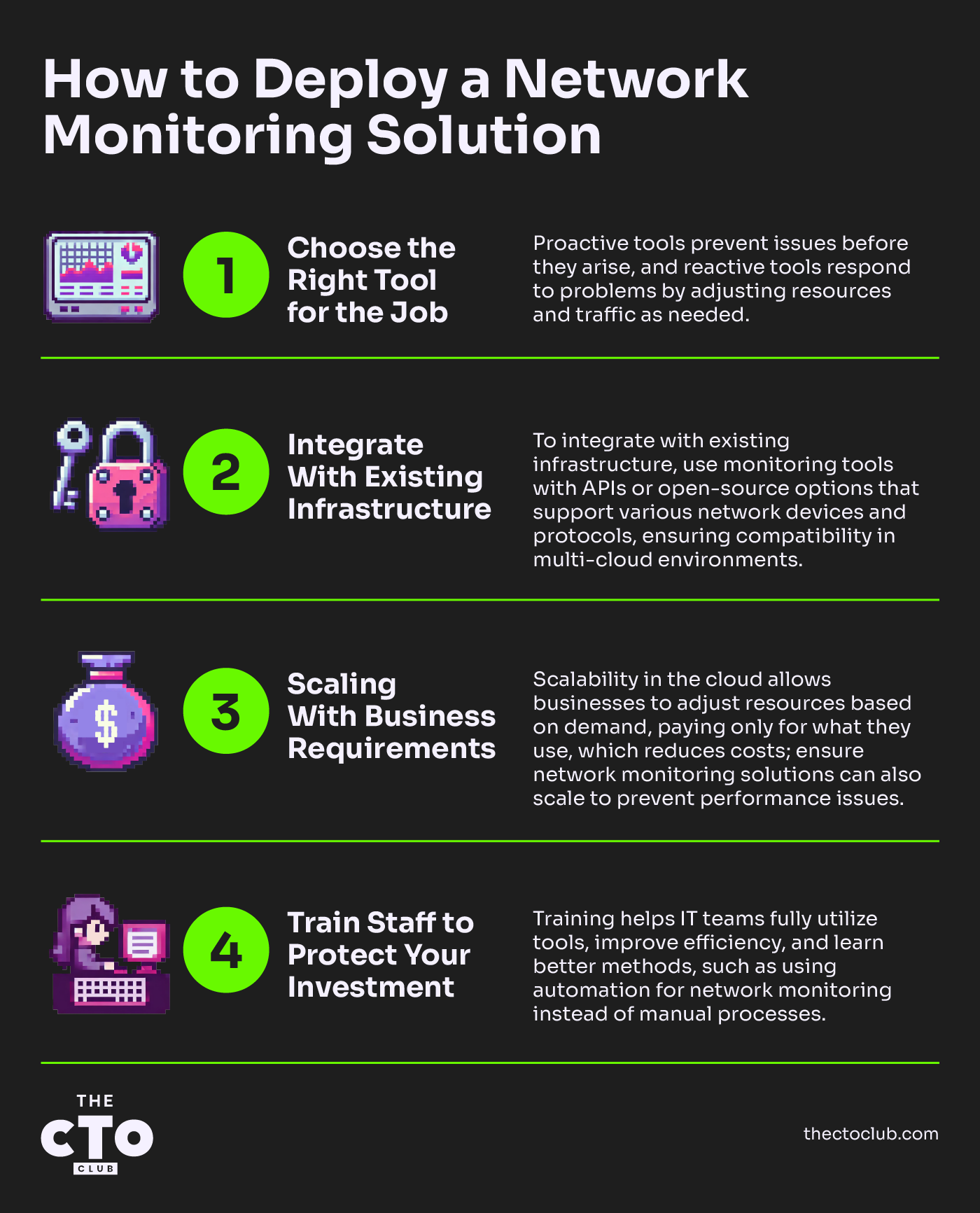Watchful Guardians: Network monitoring software keeps the digital heartbeat steady by ensuring network health, which guarantees seamless user and application connectivity.
Answering the Call: Tech leaders utilize network monitoring to provide stakeholders such as users and executives with clear, concise answers through accurate data gathering.
Path to Clarity: Adopting effective network monitoring solutions empowers organizations with better decision-making capabilities, driven by a deep understanding of their network infrastructure.
The goal of network monitoring software is to maintain the health and efficiency of the network infrastructure, ensuring seamless connectivity and service availability for users and applications.
As a tech leader in your organization, monitoring network traffic helps you answer questions from stakeholders – users, auditors, accounting, and C-suite members – with clear and accurate data.
This guide explores the concepts you need to move your organization closer to an effective network monitoring solution that enables better decision-making.
What is Network Monitoring?
Network monitoring is the systematic process of overseeing and managing a computer network to ensure optimal performance, reliability, and security.
It involves using specialized software tools to identify and report problems with network components such as routers, switches, firewalls, servers, and other network-enabled devices, allowing network administrators to address issues before they impact users or business operations.
Proactive and reactive analysis of traffic and hardware guarantees network integrity. Tools look at:
- Connected devices, such as routers, switches, and firewalls, to confirm functionality.
- Traffic patterns, congestion, and utilization to scale or adjust network capabilities.
Such monitoring is critical in SaaS environments, where employee productivity is tied directly to network efficiency and availability. When your employees require network connectivity to run even basic applications, that network must handle the demand.
-

ManageEngine OpManager
Visit WebsiteThis is an aggregated rating for this tool including ratings from Crozdesk users and ratings from other sites.4.3 -

Auvik
Visit WebsiteThis is an aggregated rating for this tool including ratings from Crozdesk users and ratings from other sites.4.7 -

SuperOps
Visit WebsiteThis is an aggregated rating for this tool including ratings from Crozdesk users and ratings from other sites.4.6
Why is Network Monitoring Important?
Network monitoring is the unsung hero of IT infrastructure, quietly working behind the scenes to ensure your systems are running smoothly. In a world where businesses rely on constant connectivity, any network downtime or performance lag can lead to lost revenue, reduced productivity, and frustrated customers.
Need to keep a close eye on your entire network environment? Network monitoring helps identify potential issues before they escalate into full-blown outages. By proactively tracking performance metrics like bandwidth usage, latency, and device health, network monitoring helps IT teams resolve bottlenecks quickly and maintain seamless operations.
Benefits of Network Monitoring in SaaS
By leveraging a range of concepts and best practices, your organization can effectively utilize network monitoring to guarantee the availability of SaaS resources.
Today's monitoring software offers an extensive array of services, from sophisticated analytics to seamless scaling, empowering your team to achieve and maintain optimal performance.
- Improved Network Performance and Reliability: Continuously tracking network performance identifies and rectifies issues like slow or failing components quickly, ensuring smooth and reliable network operation.
- Proactive Problem Resolution : Network monitoring enables proactive measures to prevent downtime or significant disruptions.
- Enhanced Security: Regular monitoring helps identify unusual network activities that could indicate security breaches, such as unauthorized access or malware attacks, allowing timely response to these threats.
- Optimized Resource Utilization: Monitoring provides insights into how network resources are used, helping optimize bandwidth, balance loads, and improve overall network efficiency.
- Cost Savings: By preventing major failures and optimizing network resources, network monitoring can lead to significant cost savings. It reduces the need for emergency repairs and downtime, which can be expensive and damaging to business operations.
- Better User Experience: A well-monitored network typically translates into a smoother experience for end-users, with fewer disruptions and faster, more reliable access to network resources and applications.
- Data-Driven Decision-Making: Network monitoring generates valuable data about network performance and usage patterns, aiding in informed decision-making for future network planning, upgrades, and expansions.
- Compliance and Reporting: Network monitoring provides the tools and reports to ensure and demonstrate compliance for businesses that need to comply with industry standards and regulations.
Network Monitoring Pillars
Many standard features and measures of network monitoring solutions apply directly to innovators in SaaS environments. Traffic on the network still boils down to basic packets, and you need them to arrive at their destinations as quickly as possible.
Construct your SaaS network monitoring design on these four pillars:
- Real-time analysis and reporting: Timeliness is essential in monitoring to enable effective responses to potential problems or outages.
- Automated alerts and notifications: Automation provides the right information at the right time.
- Performance benchmarking and optimization: Baselining network services provides a foundation for troubleshooting and optimization.
- Security and compliance: Monitoring helps ensure compliance in regulated industries. It also serves as a critical security component, providing availability and integrity.
Network Monitoring Best Practices
Use these network monitoring best practices to ensure your SaaS monitoring solution meets your organization's needs.
| Best Practices | |
|---|---|
| Build custom dashboards for stakeholders | Dashboards are critical for IT professionals tasked with monitoring. Custom dashboards display the information your organization needs quickly and effectively, enabling relevant information to be given to other stakeholders. |
| Establish effective baselines | You (and your monitoring software) can only detect abnormal if you know what normal looks like. Baselining is also critical for root cause analysis. |
| Understand proactive and reactive solutions | Think of proactive as incident avoidance and reactive as incident response. Both are essential. |
| Scale monitoring with your business | Scaling is one of the biggest benefits of cloud services. As your deployments scale up and down, your app performance monitoring software must do the same, and it must do it as quickly as the components you're monitoring. |
| Provide highly-available monitoring | If monitoring services are unavailable, you'll miss alerts and other crucial data about your SaaS systems. Monitoring outages or downtime is as important as service issues. |
| Avoid monitoring sprawl | Utilize a consistent and concise group of monitoring tools. Avoid an ever-expanding range of utilities that don't work well together and increase the complexity of monitoring your SaaS resources. |
| Continuous security monitoring | Continuous network monitoring is a key aspect of cybersecurity software, ensuring 24/7 security. This system consistently checks network service availability, a critical requirement for SaaS solutions. It not only aids in maintaining steady uptime but also helps differentiate between normal traffic and potential threats like DDoS attacks. |
| Gather data from multiple devices | Monitor network performance at multiple layers, including basic bandwidth and application service availability. Centralize data using tools like Simple Network Management Protocol (SNMP) to gather information from web servers, load balancers, edge devices, etc. |
How to Deploy a Network Monitoring Solution
A network monitoring solution provides real-time insights and analytics, allowing for swift responses to network anomalies. It's a smart way to keep your network's health in check, ensuring your services run smoothly and reliably. What are some essential considerations when choosing and setting up the best network monitoring solution?

Choose the Right Tool for the Job
Selecting the right tool to meet your strategic objectives is critical. Begin by understanding what metrics to measure and what potential failures to predict.
- Proactive: Identifies potential problems or failures before they occur, allowing IT admins to prevent the issue and maintain availability.
- Reactive: Identifies failures or congestion and reacts within specified parameters by scaling up resources, redirecting traffic, or reprioritizing specific communications.
Integrate With Existing Infrastructure
SaaS vendors, Cloud service providers, and other software companies often provide out-of-the-box computer network performance monitoring solutions for their products. Look for monitoring tools with available APIs or open source tools you can modify to work with your existing network devices.
Today's multi-cloud world and interoperability expectations mean that broad, cross-platform solutions are more common than ever. Protocols like SNMP deliver performance information from a variety of sources. You can secure these protocols using tunneling solutions like Secure Shell (SSH).
Make sure to perform an in-depth analysis of the entire network that identifies your data center's components, applications, bandwidth, security layers, and other functions impacting network traffic measurement.
Network mapping software like Nmap helps you understand the topology, including servers and endpoints. Many network devices run disparate operating systems, like Microsoft Windows or Linux, or come from various vendors (Cisco is a popular example).
Scaling With Business Requirements
Recall that this discussion of network monitoring focuses on cloud technologies, specifically SaaS. Cloud services put a new spin on network monitoring, and it is especially apparent with scaling.
A common cloud selling point is scalability, which refers to growing and shrinking workloads based on specific thresholds over time. Businesses only pay for the resources they consume, reducing capital expenditures for underutilized hardware and turning spending into operating expenditures. SaaS cloud services expand and contract on demand. Monitoring must also scale to avoid bottlenecks, so carefully shop for this feature when evaluating network monitoring solutions.
Train Staff to Protect Your Investment
Avoid investing business resources in IT solutions and then skimping on training for your network administrators. You wouldn't buy a car without knowing how to drive, would you? Training enables your IT teams to maximize the organization's investment by using the management tools correctly, efficiently, and to their fullest potential. Most IT people learn best through hands-on opportunities. Many vendors offer certification programs along with technical training.
As a technical trainer, I meet many administrators and business leaders who say, "I already know this stuff." While that may be true, training also shows you more effective ways of accomplishing standard tasks. This is most apparent with automation, where network issues administrators could handle manually are more efficiently completed through automated network monitoring features.
The Future of Network Monitoring
Network monitoring will become the backbone of organizational resilience, integrating AI and IoT advancements to predict and preemptively resolve network issues. This will transform how businesses operate and thrive in a digitally driven world.
Automated problem resolution in network monitoring is also poised to revolutionize IT management. Leveraging advanced AI algorithms will proactively identify and rectify network issues, drastically reducing downtime and freeing IT professionals to focus on strategic innovations rather than routine troubleshooting.
The continued integration of smart and IoT devices increases the demand to upgrade network services and availability. Hundreds or even thousands of nodes may be quickly brought online, each sending its data to a central point. Network professionals must account for the increased security threats, traffic, and availability of these components.
Final Thoughts
Essential strategic goals, including AI adoption, network security, and sustainability, top the to-do lists of today's IT decision-makers. Proactive network performance monitoring tools allow predictive prevention of performance issues before they interrupt business operations, while reactive components return services to normal states after incidents.
Subscribe to The CTO Club Newsletter for more insights and trends on SaaS solutions and performance data.








